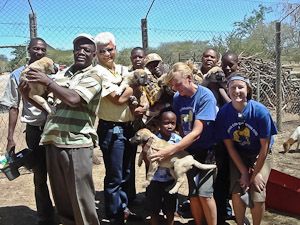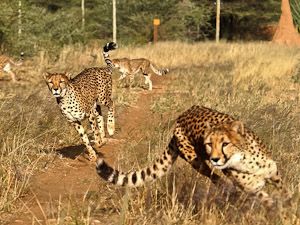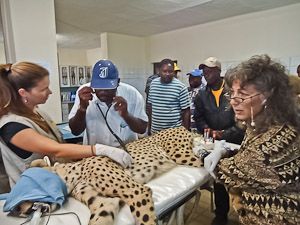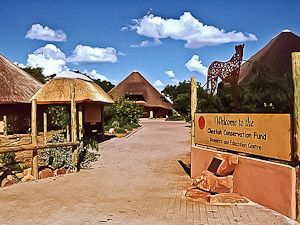

Dr. Laurie Marker: The cheetah was once a common animal found on five continents. It is now listed by the Convention on International Trade on Endangered Species (CITES) as a vulnerable species. Loss of habitat, conflict with other large predators responsible for pushing them out of protected areas, conflict with humans, and loss of genetic variation are the main threats facing the cheetah today. Its population has gone from about 100,000 animals in the early 1900s to the ten thousand believed remaining today. Cheetahs need large expanses of land to survive; with changes in land use and habitat pressures like bush encroachment, such areas are becoming increasingly smaller. Unfortunately, captive breeding efforts have not proven sufficient for the cheetah's lasting survival.
Currently, the largest numbers of cheetah populations are found in Namibia. Why do you think this is the case? Can other African countries emulate Namibian rates of Cheetah survival?
Due to severe drought and lack of knowledge about cheetah biology, there was a drastic decline in the Namibian cheetah population in the 1980s; the population was halved in a ten-year period, leaving an estimated population of less than 2,500. At the beginning of the 1990s, when the Cheetah Conservation Fund (CCF) began its work with the farming community, a gradual change occurred. Over the last few years, we have seen the cheetah population stabilize; today it may be near four thousand – making it the largest cheetah population of any African country.
CCF's research shows farmers now have more tolerance for cheetahs and are killing fewer; those that are killed are linked to livestock losses. More frequently, farmers are calling on CCF. For twenty years, CCF has worked with farmers to help them practice appropriate livestock, wildlife, and rangeland management, as well as learn more about how cheetahs live in their farmland systems.
We actively work with other countries to show them what we have done in Namibia. We have had over 300 international conservation professionals – from over fifteen cheetah range countries – partake in the International Conservation Biology Courses that we have conducted over the past three years. We are building teams to put into action management, training, research, and education programs in each county, as human population growth and subsequent loss of habitat is a critical issue in much of Africa.

In general, the most frequent causes of conflict between humans and predators have to do with financial losses. If a livestock or a game farmer believes a cheetah is attacking his animals, the cheetah is considered vermin and will most likely be shot. Thankfully, CCF's education programs, which are based on scientific research, have greatly contributed to farmers' changing attitudes – resulting in a better understanding of cheetah behavior and improved livestock and wildlife management. This shift in attitude combined with conservation programs like CCF's Livestock Guarding Dog program (LSDG), have become very important tools for a more integrated approach to livestock and predator management.
Another of the farmers' complaints is that cheetahs hunt livestock (usually inside unsafe enclosures) and leave the kill. Cheetahs will make a kill and eat as fast and as much as they can, but they do not return to their kills once they leave. Farmers often think this is wasteful. However, the kills feed numerous other carnivores, resulting in a symbiotic relationship in the wild. For instance, if jackals feed off what cheetahs leave behind, then they will leave farmers' livestock alone. Cheetahs also feed vultures and other small carnivores, which keeps the ecosystem healthy. Also, if a farmer's kraal or enclosure is not predator-proof, and a cheetah (or any other predator for that matter, including domestic dogs) enters, the animals run. The instinct of predators is to chase and kill. So, in a way, farmers can play a role in this kind of killing by not constructing safe or sturdy kraals.
On your website you talk about the "human animal" saving nature. At Izilwane, we believe humankind needs to recognize its identity as a fellow animal in order to shift perceptions about life on earth. What have you found to be effective ways to engage people in your projects, and make them feel as though they have a stake in Cheetah prosperity?
This is GREAT!!! I like you!!!!
I feel we need to involve the entire world in predator conservation. Changing human behavior is very difficult, and it takes time – I have heard that it takes years, even generations. So, in terms of predator-hatred, we have behind us thousands of years of hating (fearing) predators around the world. I believe we have to show people how to change; we need to make it to their financial benefit to change. We can't ask for too much, but we can suggest a few small changes at a time. Studies show that positive reinforcement works better than negative feedback. This is why I think consumers can assist greatly by buying products from people who are farming with predators and using good livestock management. To highlight such farmers will make them feel good about their work practices.
We also need the western world to see Africa in a different light. People living in poverty are going to care about their own needs long before they care about conservation, but we must continue finding benefits for poor people living with predators (and other wildlife). We need to be creative in development work and link conservation to health care. In addition, we need to find alternative livelihoods for people living in predator areas.
I always tell people that animals... think we are wonderful for placing our livestock in their home ranges. We, as humans, have access to the books and [research]. We need to present this information to the people in a palatable way, so they can understand their role in wildlife-human conflict.

The decrease in genetic diversity resulting from natural selection has benefited the species' survival, as it has made the cheetah better adapted to its environment, though more vulnerable to disease. However, cheetahs lack the ability to adjust to sudden changes in the environment, such as disease epidemics, and have unusually high susceptibility to certain viruses. If a virus gets into a healthy population of leopards, only some animals die because leopards are genetically diverse. In the case of the cheetah, which lacks genetic diversity, infection spreads easily and increases the death rate. In addition, lack of genetic diversity can affect reproduction, which plays a major role in species survival. We have seen high numbers of abnormal sperm in cheetahs. Our collaborators have studied the Florida panther – a sub-species of cougar whose population twenty years ago was down to approximately fifty individuals. The males had sperm that was over 90 percent abnormal and most were cryptorchoid (one, or both, testicles had not descended.) This was the result of genetic diversity and was a huge hindrance for successful reproduction.
Though the cheetah has suffered from inbreeding and high infant mortality, it is the oldest of the big cats and has survived the longest. If we can provide a habitat and a rich prey-base on livestock farmlands of southern Africa, the cheetah's race will be one of survival, not extinction.
What can be done about genetic diversity among cheetahs?
To increase genetic diversity in captivity, zoos take great care to make sure that only unrelated animals mate. Scientists are working on ways to enhance breeding through artificial insemination (A-I), and in vitro fertilization (IVF). Because of genetic inbreeding, male cheetahs have poor sperm quality. Abnormal sperm (over 70 percent) cannot swim properly, reducing the chance of fertilizing eggs and producing offspring. A-I is a laboratory technique whereby scientists place sperm in females' reproductive tracts (in cheetahs, it is done laposcopically). This means the sperm have less distance to swim before reaching the eggs. A–I has produced cheetah cubs in the United States. Using these technologies, semen and eggs can be collected from wild cheetahs for use in captive breeding programs, and eventually diversify the genetic make-up of small populations in the wild. Because Namibia has the largest population of cheetahs, its genetic make-up is important to captive cheetah survival worldwide.
To increase genetic diversity in the wild, we need to stop indiscriminate killing and develop protected land corridors from one wild population to another. If we cannot accomplish this through natural movements, we will eventually need to manually move animals from one population to another – this is called Meta-Population Management. We may never substantially increase genetic diversity, but we can prevent further decrease.

Working with and for the fastest land mammal is amazing – they can reach speeds of up to 110 kilometers (approximately sixty-eight miles) per hour. The cheetah's athletic ability, as well as its family and social bonds are so special. Understanding more about how cheetahs live and behave keeps me going... I think people could learn a lot about cooperative living from watching cheetahs! They are social animals; the females are the world's best moms and the males, living together as coalitions, are so bonded and loyal.
Can you tell us a little about Chewbakka?
You may have read a lot about Chewbaaka lately. He was my best friend ever since he was brought to me in 1995 – only ten days old and seriously ill. Even when young and sick, he was a fighter and he pulled through. We developed a deep bond that lasted his lifetime. We trusted each other completely. We were partners. Khayam, the first cheetah I raised, showed me the problems facing cheetahs; Chewbaaka showed me solutions. As a team, we demonstrated to tens of thousands of Namibians that we can live together peacefully.
Chewbaaka was an icon of wildlife conservation. So many people met him when they visited CCF in Namibia. For fifteen years, he showed people what makes cheetahs so fascinating. His blazing speed put into perspective just how fast the cheetah is, and left many jaws agape. He made Namibians proud of their natural heritage. He convinced men who had killed cheetahs all their lives to put down their guns and work to protect this fascinating animal. And, his regal bearing left an indelible impression on everyone who met him – from young children to heads of state.
The friendships I shared with Chewbaaka, Khayam and, more recently, with the Stars and OK cubs, are relationships that go beyond words. I was part of their family, and they were my teachers. It's hard to think of them as animals; they are just different kinds of friends. Our interactions are on a human level. They don't understand our world, but they learned to trust me. It was as if they were a part of the human world – it was about trust.
What is your proudest or most inspirational moment working with cheetahs?
When a cheetah I know looks me straight in the eye and purrs!
Each day is inspirational for me. It feels so good when we are able to release cheetahs back into the wild, and it makes me proud that I have been able to do this. Over six hundred have returned to the wild! And, over the past couple of years, we have re-established a population in southern Namibia, where they had been extinct for more than forty years.
There are currently only two hundred cheetahs in Iran. I was surprised to learn cheetahs exist there at all. Is the CCF conducting any programs in this area?
Actually, there are fewer than one hundred cheetahs in Iran. I have worked with the Iranians for over ten years. We have trained more than thirty people at CCF; we have hosted several top members of the Iranian Wildlife Department and have helped develop the Iranian Cheetah Society. In addition, we currently collaborate with the Iranian government on their cheetah program, and we’ve helped develop a ten-year Management Plan and the next ten-year Action Plan. CCF helps with training and shares program successes in all cheetah-range countries, including twenty-four African countries and, of course, in Iran. In many of these countries, efforts are currently underway to develop new conservation programs and to support existing cheetah conservation efforts. CCF's international program includes distributing materials, lending resources and support, and providing training throughout Africa and worldwide.

These dogs are originally from Turkey, where they have been used to protect livestock against wolves and bears. CCF saw the potential these breeds could have in efforts to minimize conflict with predators on Namibian farmlands. The dogs' natural instincts to protect the flock, paired with the cheetah's flight vs. fight instinct, made these dogs the ideal choice.
This program is an extension of a livestock management practice already used by Namibian farmers. Some farmers have used smaller breeds to protect their animals, so introducing these dogs was a logical extension of the practices already in place.
Currently, we have over 130 working dogs. We just had twelve puppies born from two litters, and we will have a couple more litters this year. We place the puppies when they are nine weeks old, once they have been spayed or neutered and have received vaccinations. We then check on the dogs throughout their lives to make sure that they are doing well. We also help farmers train their dogs.
As one of CCF's most intensive activities, the LSGD program costs over $40,000 per year to breed and care for the dogs, as well as educate the farmers (and costs increase yearly as the number of dogs increases.) Donations help support this life-saving program for wild cheetahs. There are ways to aid this program; people can sponsor a Livestock Guarding Dog or let friends and family know about our work with these amazing breeds.
Some additional programs not mentioned in the article include CCF's involvement in the Cat Specialist Group of the World Conservation Union (IUCN), as well as its promotion of economic incentives for environmental conservation through eco-tourism and the innovative buskblok initiative. Bushblok is a fuel log made from compacted thornbush, an undesirable species of plant that encroaches on and infests cheetah habitat, restricting movement. Local Namibians are employed to collect and transform the thornbush into briquettes by using a series of using wood chippers and compressors. The bricks are then sold as an environmental-friendly and effective alternative to overexploitation of other fuel woods. To find out more about Dr. Laurie Marker and her work with cheetahs, or to try for a chance to name one of the newborn cubs, visit www.cheetah.org.
Photos are copyright protected and may not be reproduced without permission. Image of Dr. Marker and Chewbakka is courtesy of Christophe Lepetit. Other images are courtesy of the Cheetah Conservation Fund.